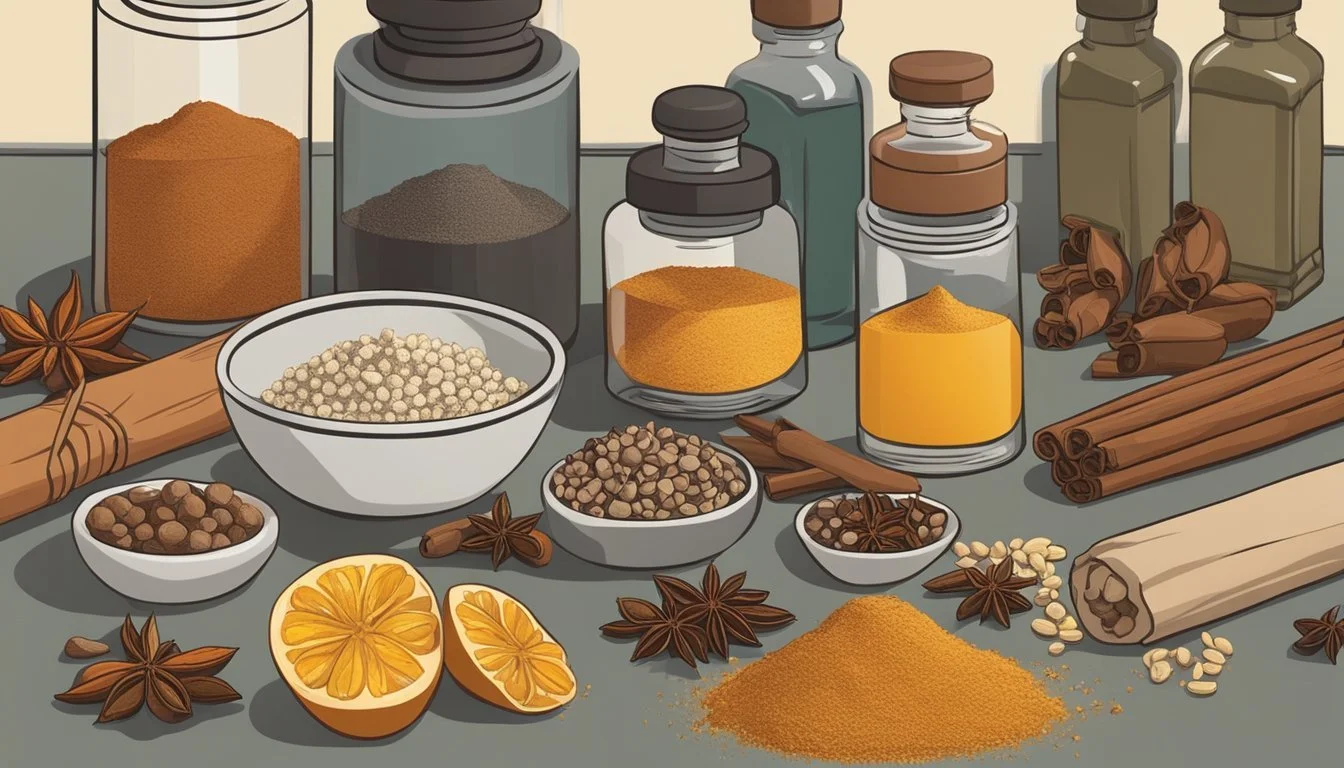Mace Substitutes
Top Alternatives for Your Spice Rack
Mace, the aromatic spice derived from the outer coating of nutmeg seeds, holds a coveted place in culinary arts for its warm, spicy-sweet flavor. It is a classic ingredient in a myriad of dishes ranging from savory to sweet, often gracing spice blends, baked goods, and even beverages. Owing to its distinct taste and the subtle complexity it brings to recipes, finding an adequate mace substitute can be a challenge for chefs and home cooks alike.
In situations where mace is unavailable, substitutes must be carefully considered to maintain the integrity of the dish. Alternatives such as nutmeg, which comes from the same tree as mace, offer a closely related flavor profile, making it the most direct substitute. A blend of spices including allspice, cinnamon, and ginger can also mimic the warm, nuanced notes of mace when combined in the right proportions. Experimenting with these substitutes allows for a continued exploration of flavor, ensuring that the absence of mace does not compromise the final outcome of a recipe.
Understanding Mace
In this section, we explore the origins, culinary applications, and the nutritional aspects of mace, a spice with a distinct flavor derived from the nutmeg tree, which is indigenous to Indonesia's Banda Islands.
Origins and Uses
Mace is the outer covering of the nutmeg seed, produced by the nutmeg tree (Myristica fragrans) that originated in the Moluccas, also known as the Spice Islands of Indonesia. This lacy aril is gently removed from around the nutmeg seed, dried, and often ground into a spice.
Geographical Origin: Indonesia, specifically the Banda Islands
Native Tree: Nutmeg tree (Myristica fragrans)
The spice is frequently employed in both sweet and savory dishes. It imparts a slightly warmer and less intense flavor than nutmeg and is popular in baking, particularly in spice mixes for desserts like cakes, puddings, and custards.
Culinary Impact
Mace boasts a complex flavor profile characterized by a combination of warm, spicy, and slightly sweet notes with a hint of bitterness. This aromatic spice is versatile in cooking, enhancing the taste of a variety of recipes.
Flavor Profile: Warm, spicy, sweet, and slightly bitter
Use Cases: Savory dishes such as stews and soups, and desserts like spice cakes and cookies
Because of its potent flavor, mace is used sparingly and can be found as a constituent in spice blends like garam masala, contributing to the overall depth and richness of the dish.
Nutritional Profile
While mace is generally used in small amounts that do not contribute significantly to one's daily nutritional intake, it contains compounds that are known for their anti-inflammatory and antioxidant properties. The spice contains a range of essential oils and chemical compounds that can impart health benefits.
Essential Oils: Myristicin, elemicin, eugenol, and safrole
Potential Benefits: Anti-inflammatory and antioxidant properties
As with many spices, the nutritional content is most impactful when mace is consumed as part of a balanced, varied diet.
Identifying Substitutes
When seeking a mace substitute, it is crucial to consider the flavor profile, the dish's requirements, and the substitute's availability.
Characteristics of an Ideal Substitute
The best mace substitute should closely match the original spice's pungent flavor and slight sweetness without overpowering a dish. It should possess a warm aroma and maintain the intended taste of the recipe. Nutmeg, with its similar flavor profile, is often the preferred choice.
Common Mace Alternatives
Several spices can act as a mace substitute in both savory dishes and desserts. The following are commonly used alternatives:
Nutmeg: Offers the closest match in flavor.
Cinnamon: Provides a warm, sweet taste.
Allspice: Delivers a blend of cinnamon, nutmeg, and clove flavors.
Clove: Best used in half the amount due to its strong flavor.
Ginger: Adds a spicy note to recipes.
Pumpkin Pie Spice: A blend that mimics mace's warm complexity.
Cardamom: Has a unique flavor, suitable for certain recipes.
Garam Masala: A spice mix that can provide similar warmth and depth.
Factors Affecting Substitute Choice
The choice of substitute for mace will depend on the specific recipe and desired outcome. For instance, cinnamon or allspice may suit desserts, while garam masala or nutmeg may be better for savory cooking.
Availability and Accessibility
Most mace substitutes, like nutmeg and cinnamon, are staples in the average American pantry or spice cabinet. Cardamom and garam masala may require a visit to a health food store or a well-stocked supermarket.
Cost Considerations
The price of a mace substitute can vary, with common spices like cinnamon being more affordable compared to less common spices such as cardamom. Nutmeg is usually the most cost-effective substitute for mace, given their similar flavor profiles.
Using Substitutes in Cooking
When cooking with substitutes, it is crucial to match the substitute's flavor profile with the intended taste of the dish. The strength and nuances of the spice should complement the main ingredients, whether in desserts or savory meals.
Dessert Recipes
In dessert recipes, where the delicate balance of sweetness and spice is key, one should select substitutes that offer a similar warmth and aromatic quality to mace. For example, when baking an apple pie or preparing rice pudding, a blend of cinnamon and nutmeg can provide the desired sweet aromatic flavor that mace typically offers. Nutmeg, being from the same tree as mace, is the most direct substitution. Apple pie spice, which contains cinnamon, nutmeg, and allspice, can also be an excellent addition to desserts like cookies that require a hint of spice.
Savory Dishes
For savory dishes, the substitute choice depends heavily on the type of meat or seafood being used. Allspice and a pinch of cardamom can bring the depth of flavor needed, especially in dishes that involve braising or slow cooking. Meats such as lamb or beef, which can handle more robust spices, can be flavored with these substitutes to closely mimic mace's complex taste. For a soup or soup base, it's ideal to use mace substitutes sparingly as their flavors intensify with prolonged cooking.
Seasonal Cooking
Seasonal cooking often calls for mace's unique flavor, particularly in fall and winter dishes like recipes incorporating winter squash or pumpkin spice blends. However, when mace is unavailable, a homemade mix of ginger, cinnamon, and allspice can yield a similar festive taste profile suitable for the season's hearty dishes. These spices should be used with a measured hand to avoid overpowering the dish and to sustain the comfort and warmth that mace would traditionally impart.
Cultural and Regional Variations
When exploring mace substitutes, it's important to consider how the spice's absence or replacement will impact the traditional flavors of a region's cuisine. Each culture brings a unique set of spices and culinary practices to the table, influencing the choice of substitute.
Asian and Indian Cuisine
In Asian and Indian cooking, where mace is often a component of complex spice blends, chefs typically look for substitutes that align with the warm, aromatic qualities of the original ingredient. Garam masala, a blend that sometimes includes mace itself, can provide a similar bouquet of flavors. Here, cumin is another common element with a warm, earthy profile that supports the overall taste of many dishes characteristic of these regions.
Common substitutes in Asian and Indian cuisine:
Garam masala
Cumin
Cardamom
Mediterranean and European Flavors
Mediterranean and European dishes that typically utilize mace can benefit from substitutes that mimic the warm and slightly sweet profile of the spice. The Spice Islands, once central to the trade of mace, influenced numerous Mediterranean recipes. Utilizing spices like nutmeg, which is the seed from which mace derives, can provide a familiar nuance to these cuisines.
Typical substitutes in Mediterranean and European recipes:
Nutmeg
Cloves
Allspice
African and Moroccan Influences
The use of mace in African and Moroccan cuisines often lends a depth of flavor to savory stews and pastries. In these regions, if mace is unavailable, chefs may use complex blends that may include a variety of warming spices that are principal to the local flavor profiles, such as ras el hanout in Moroccan cuisine. This spice mix often contains many of the same components found in garam masala, capitalizing on the intricate balance of spices.
Substitutes frequently used in African and Moroccan cuisines:
Ras el hanout
Cumin
Caraway




